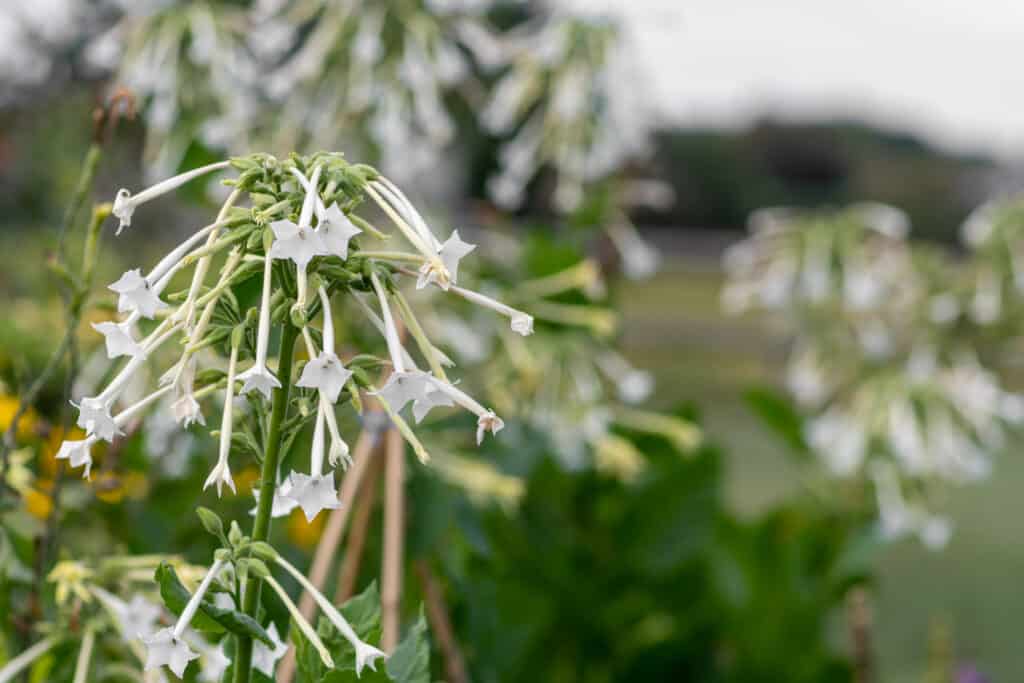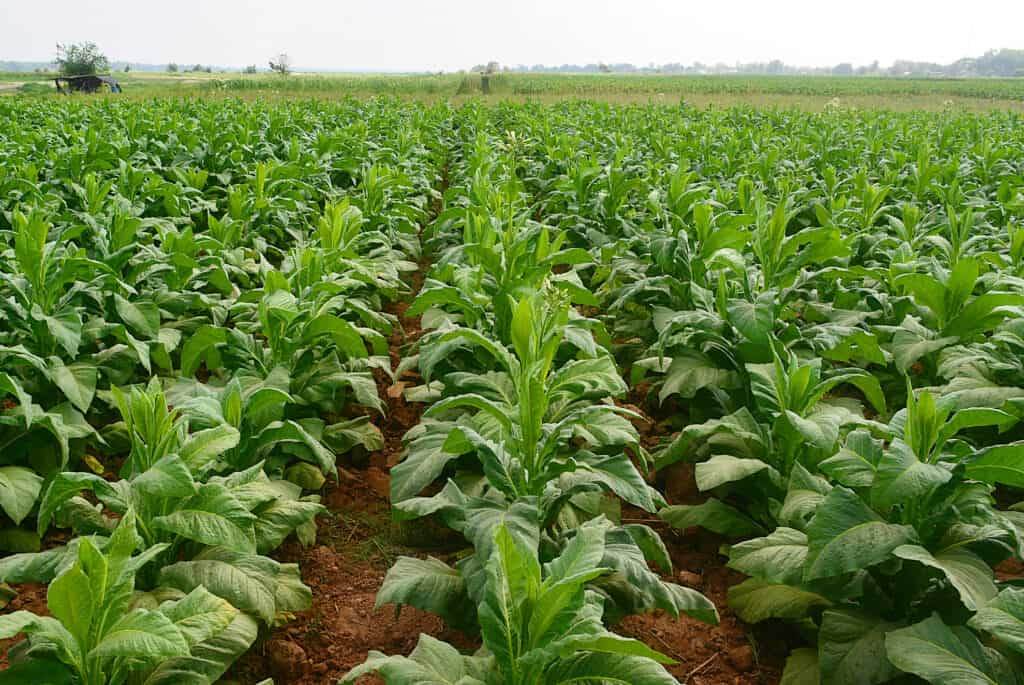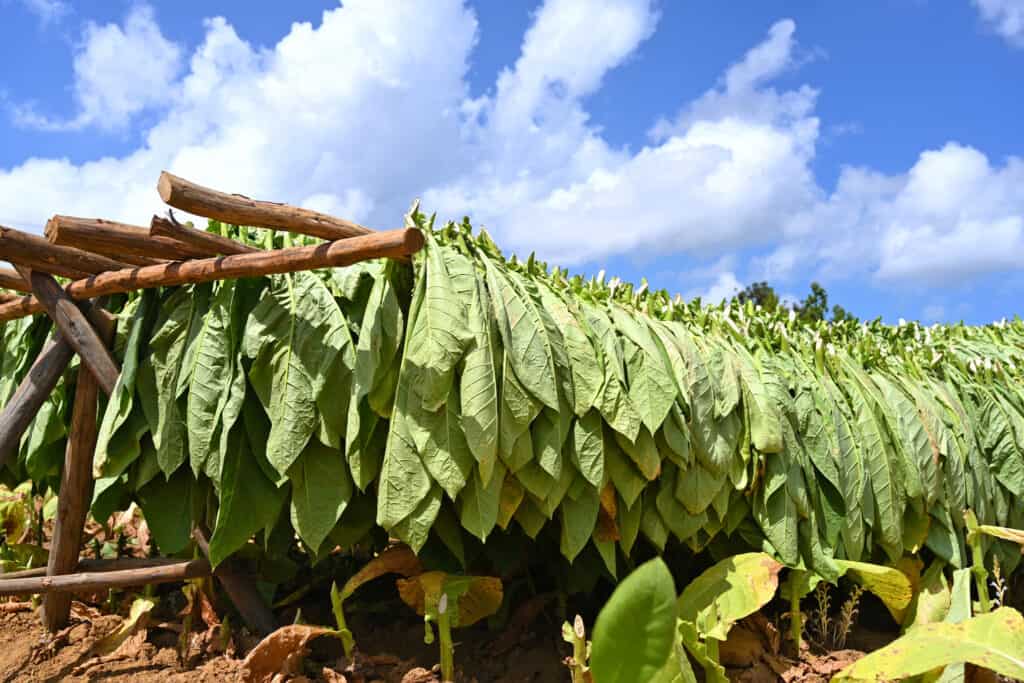Flowering tobacco and true tobacco are members of the genus nicotiana, which contains over 80 species of tobacco. Flowering tobacco is an ornamental plant cherished for its beauty. True tobacco, on the other hand, is a plant that produces nicotine and is commonly used in smoking products.
Looking at the differences between true tobacco and flowering tobacco, we will discover whether or not these two fascinating nightshades would be a fitting addition to your garden.
Comparing Flowering Tobacco to True Tobacco
| Flowering Tobacco | True Tobacco | |
|---|---|---|
| Classification | Nicotiana sylvestris | Nicotiana tabacum |
| Alternative Names | ornamental tobacco, woodland tobacco, South American tobacco | cultivated tobacco |
| Origin | South America | South America |
| Description | A type of tobacco or nightshade plant that grows ornamental white flowers | A type of tobacco (nightshade) plant with leaves that are dried and processed to be used in nicotine products |
| Uses | landscaping and aesthetics | nicotine containing products |
| Growth Tips | Plant in sunny spots with a bit of shade and ensure that the soil is rich and moist | Plant in well-drained soil, as tobacco roots are sensitive to over-watering |
| Interesting Features | This plant is poisonous when eaten | The cultivation and uses of tobacco have been documented for thousands of years, as far as 5000 B.C. |
Key Differences
Both flowering tobacco and true tobacco are part of the same genus, nicotiana. However, they are vastly different plants with very different uses. True tobacco is cultivated for its use in nicotine products, whereas flowering tobacco is used primarily as an eye-catching addition to the backyard garden.
Flowering tobacco’s blooms are prized for their aesthetic qualities, and it is only grown as an ornamental. Conversely, true tobacco is exclusively grown and cultivated for harvesting its nicotine, which the plant produces in large amounts. Flowering tobacco does not contain nicotine, and consuming any part of the flowering tobacco plant can cause illness.
Classifications
Both flowering tobacco and true tobacco are part of the nicotiana genus and solanaceae family. Nicotiana includes a wide range of additional tobacco plants, including winged tobacco and longflower tobacco plants. Flowering tobacco is classified as nicotiana sylvestris, while true tobacco is classified as nicotiana tabacum.
Descriptions
Known by the popular names woodland tobacco, blooming tobacco, and South American tobacco, flowering tobacco is a species of flowering plant in the nightshade family solanaceae. It can grow as a biennial or an ephemeral perennial. It is a tall plant that can grow as tall as 5 feet and as wide as 2 feet. The flower has clusters of white, tubular blooms suspended above the leaves. Victorian gardeners planted flowering tobacco, lining sidewalks and paths, so that those walking by could enjoy its floral scent, and flowering tobacco recently received the Royal Horticultural Society’s Award of Garden Merit.

The flowe of a flowering tobacco plantr has clusters of white, tubular blooms suspended above the leaves.
©iStock.com/Tom Meaker
Tropical in origin, and widely cultivated around the world, the nicotiana genus of herbaceous plants, including true tobacco, are annual plants. Though the research continues, studies point toward true tobacco being a hybrid of several different tobacco species.
The most widely cultivated of all tobacco species in the genus nicotiana, true tobacco is an annual plant with sticky hair on its leaves and stems, growing up to 10 feet tall. Though the stems are neither branching nor thick, the leaves of the plant can, nevertheless, reach lengths of nearly 1.5 feet long, ranging in shape from oval to elliptical. True tobacco’s flowering stalks can grow as long as one inch, and except for the seed, almost every portion of the plant contains nicotine, however, the concentration varies depending on variety, soil, and weather.

True tobacco is the most widely-cultivated non-food crop in the world.
©iStock.com/surasit bunnet
Uses
Growing flowering tobacco for decorative purposes is widespread thanks to its visual appeal and exceptionally fragrant blossoms. An ephemeral perennial, flowering tobacco grows as a half-hardy annual in colder climates. Consuming any component of flowering tobacco causes illness.
Growing true tobacco, is more widespread than ever, because harvesting it results in the production of cigarettes, cigars, chewing tobacco, snuff, and other nicotine containing products. As true tobacco ages, the amount of nicotine in the plant increases. Nicotine only flows through the leaves of immature plants, but In mature plants, nicotine courses throughout the plant’s leaves, stems and roots.

True tobacco is used in the production of cigarettes, cigars, chewing tobacco.
©iStock.com/ndcityscape
Origins
The Maya people of Central America utilized the leaves of true tobacco for smoking during holy and religious rites as early as the first century B.C. According to archeological findings, true tobacco’s use had extended as far north as the Mississippi River Valley by approximately A.D. 600, where it was embraced by nearby tribes of indigenous people. Today, true tobacco is grown throughout the world.
Flowering tobacco’s origins are more obscure. Though flowering tobacco is indigenous to the same areas as true tobacco, its appeal and spread is not as far-reaching, possibly due in part to flowering tobacco’s toxic properties and lack of commercial appeal.
Cultivation
Flowering tobacco grows best in warm soil and warm temperatures. Best practice suggests waiting to plant flowering tobacco until at least two weeks after the last spring frosts, because cold, wet soil promotes root rot. Flowering tobacco prefers consistently moist soil and full sun, making routine watering a must, though established plants may tolerate intermittent drought.
Growing true tobacco in well-drained soil and full sun will provide the best results. Soil that doesn’t drain well may cause plants to grow slowly or even die. If irrigation is not provided, drought stress may restrict the growth of true tobacco. Though most varieties prefer full sun, other types of true tobacco prefer shade. For example, the variety of tobacco used for wrapping of cigars favors shady growing conditions, which encourage the leaf to develop desirable qualities for wrapping.

Tobacco used for wrapping of cigars is grown in shade, encouraging the leaf to develop desirable qualities for wrapping.
©iStock.com/Alexandr Screaghin
Final Thoughts
Growing flowering tobacco for its showy flowers and it sweet aroma is not nearly as widespread as the cultivation of true tobacco for its nicotine. Growing, harvesting and manufacturing true tobacco is big business, which is why true tobacco continues to be the most widely-cultivated, non-food crop in the world.
Up Next:
- Best Perennial Flowers
- The Best Flowers to Plant in Texas: Flowers that Survive Heat Waves
- Extinct Flowers
The photo featured at the top of this post is © Singha Songsak P/Shutterstock.com
Sources
- wisc.edu, Available here: https://hort.extension.wisc.edu/articles/flowering-tobacco-nicotiana-sylvestris/
- wikipedia, Available here: https://en.wikipedia.org/wiki/Nicotiana_tabacum
- portlandnursery, Available here: https://www.portlandnursery.com/annuals/nicotiana
FAQs (Frequently Asked Questions)
Is flowering tobacco intended to be used the same way as regular tobacco?
No. Flowering tobacco is used as an ornamental plant for landscaping.
Is the flowering tobacco plant dangerous?
Any type of nicotiana plant is considered toxic if eaten, so it should be kept away from pets as well as children.
Are there differences between flowering tobacco and true tobacco?
There are many differences, the main difference being that flowering tobacco is a relative of true tobacco and is used for its pleasant scent and blooms in landscaping.
Thank you for reading! Have some feedback for us? Contact the AZ Animals editorial team.






